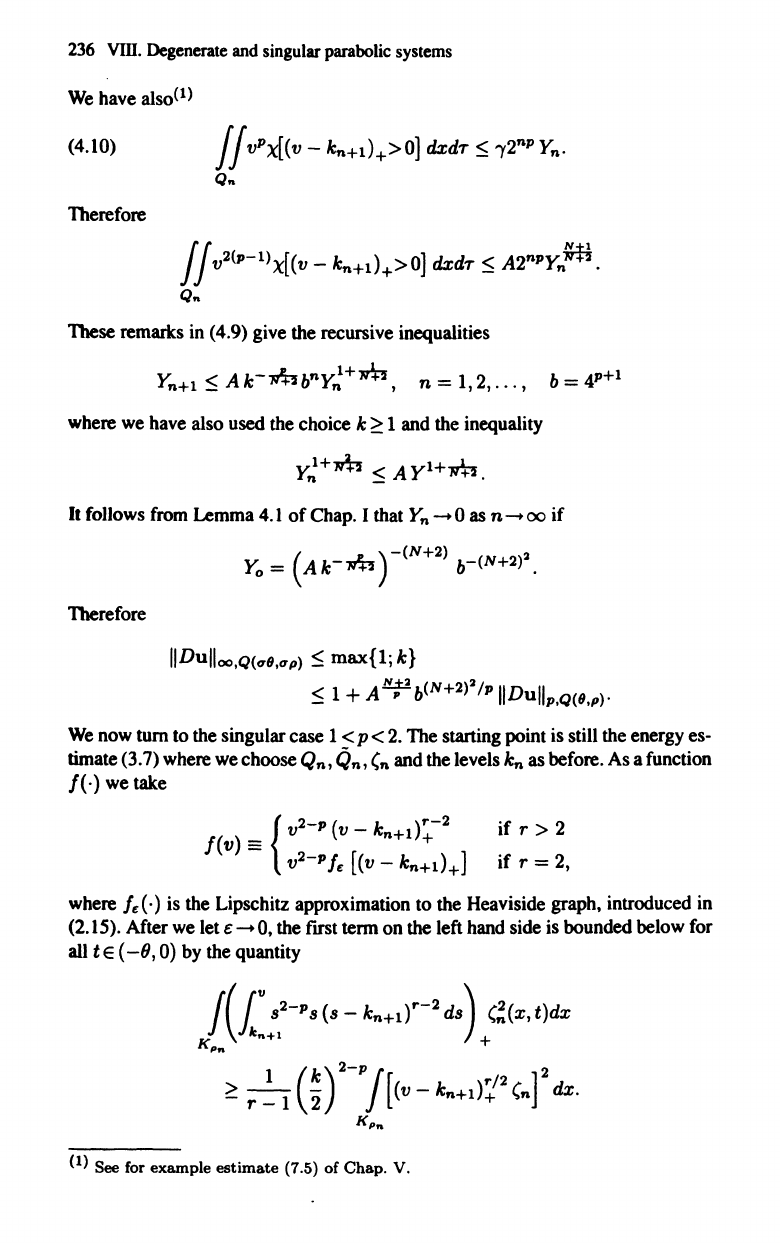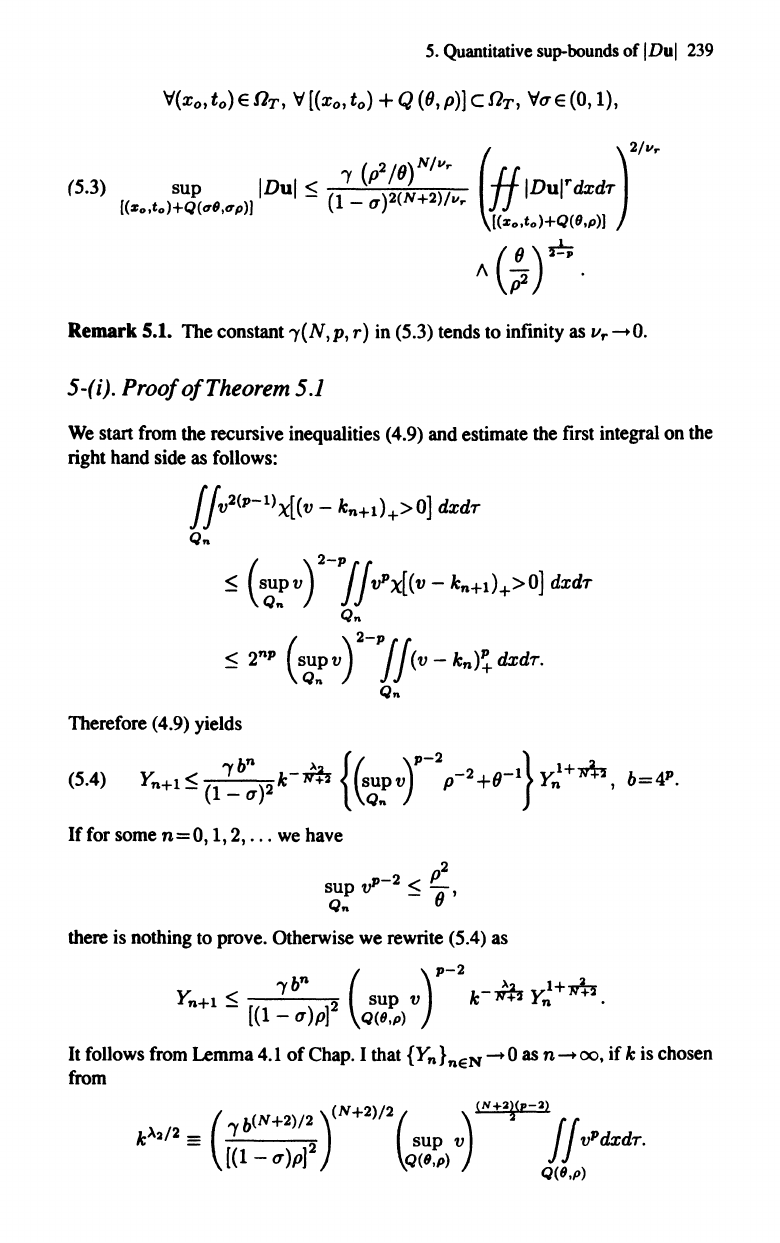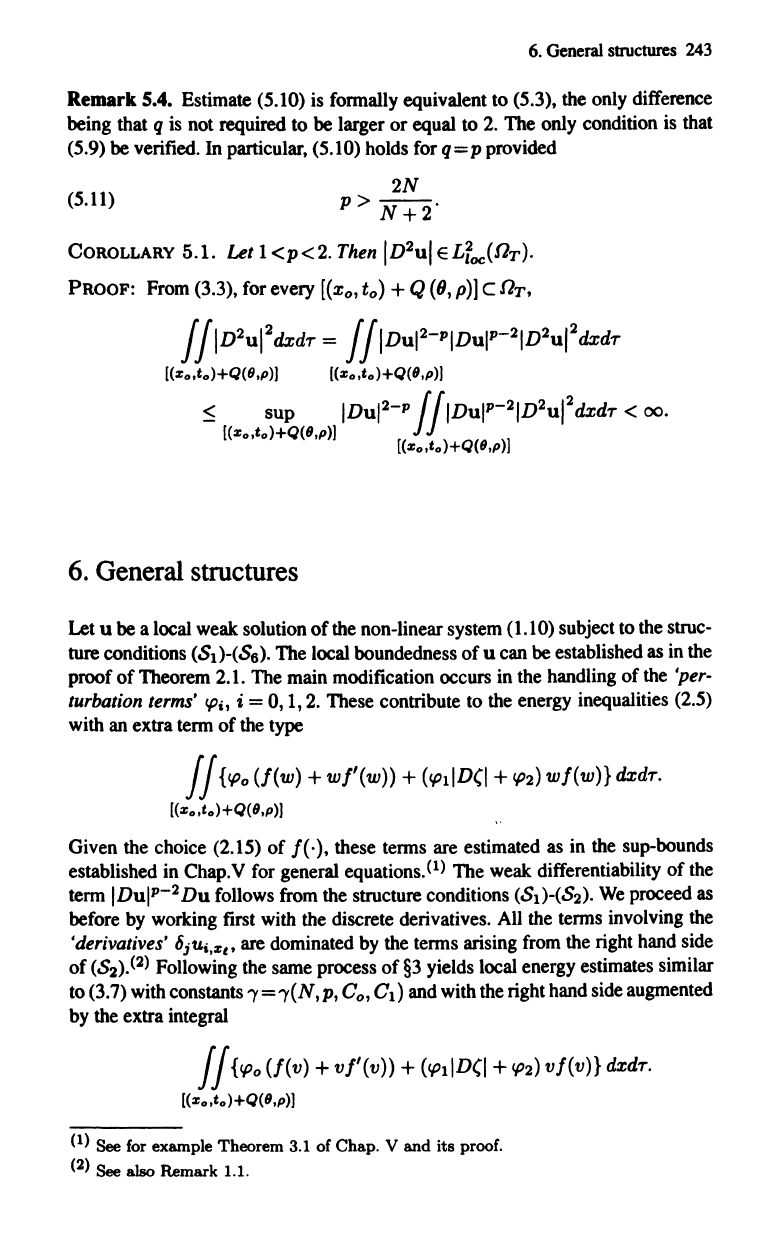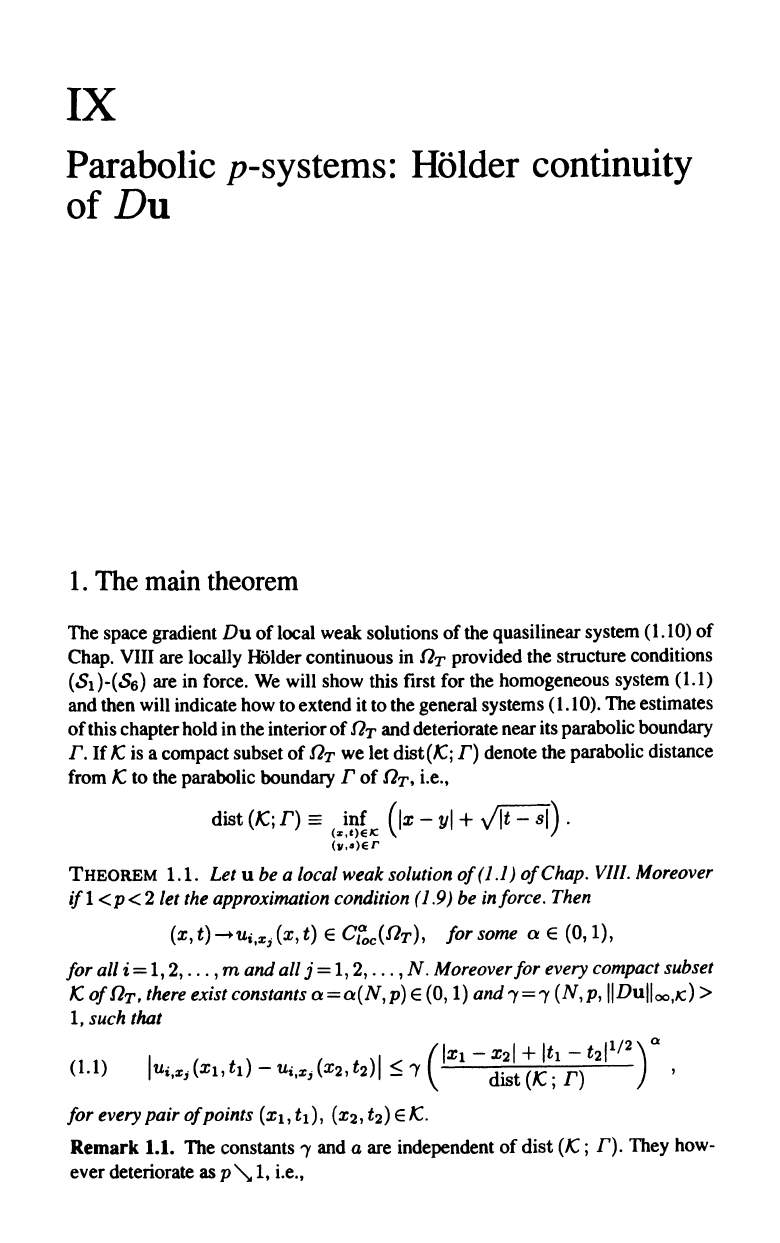DiBenedetto E. Degenerate Parabolic Equations
Подождите немного. Документ загружается.


236
VIll.
Degenerate
and
singular
parabolic
systems
We
have
also(1)
(4.10) II
vPX[(v
- kn+d+>O] dxdT
~
-y2
np
Yn·
Q
..
Therefore
II v
2
(P-1)x[(v - kn+1)+>
0]
dxdT
~
A2npYn~.
Q
..
1bese
remarks
in
(4.9) give the recursive inequalities
Y
n
+1
~
A
k-m
bny;+wh
, n = 1,2,
...
, b =
4"+1
where
we
have
also used
the
choice k
~
1 and
the
inequality
y;+wh
~
A
y1+wh.
It
follows
from
Lemma
4.1
of
Chap.
I that
Yn
-+
0
as
n
-+
00
if
Yo
=
(Ak-
m
) -(N+2) b-(N+2)2.
1berefore
IIDulloo,Q(a9,ap)
~
max{l;
k}
~
1 +
A¥b(N+2)2/
p
IIDullp,Q(9,p).
We
now
tum
to
the singular case 1 < p <
2.
The starting point
is
still
the
energy es-
timate
(3.7)
where
we
choose Qn, Qn, (n and the levels k
n
as
before.
As
a function
1(·)
we
take
if
r > 2
if r
=
2,
where
Ie
(
.)
is
the Lipschitz approximation
to
the Heaviside graph, introduced
in
(2.15). After
we
let e
-+
0,
the first term on the left
hand
side
is
bounded below for
all t E ( -fJ,
0)
by
the quantity
f(l
tJ
s2-
p
s (s - k
n
+1r-
2
dS)
(!(x,
t)dx
K
k"+!
+
p"
~
r~1
(~r-Pf[(V-kn+1)12(nr
dx.
K
p
"
(1) See for example
estimate
(7.5) of Chap. V.

4.
Boundedness
of
IDul.
Qualitative estimates
237
The term involving D
2
u is estimated below by
IIID
2
U
l2
(v -
kn+1)~-2
x[(v - k
n
+1)+>O]
(~dxdr
Qn
~
r~
IIID
(v -
kn+d12
r
(~dxdr.
Qn
Combining these estimates in (3.7) we arrive at
(4.11) k
2
-
p
sup
I [(v - kn+1>12
(n(x,
t)]
2
dx
-9<t<O
- -
K"n
+
IIID
(v - k
n
+1)1
2
(n1
2
dxdr
Qn
where 'Y='Y(N,p, r). To simplify the symbolism we set
(4.12)
Sn=
JI(v-kn)~dxdr,
Qn
and combine (4.11) with the embedding
of
Proposition
3.1
of
Chap. I. with m =
p=2
and
q=2(N
+
2)/N.
This gives
(4.13)
'Y
2(r+2)n
2
(2N"~+r
wh
Sn+1
~
(1-0')2
k-
+
Sn
+
X
{p-2
Ilvrx[(v
- kn+d+>
0]
dxdr
Qn
+
6-
1
II
v
r
+(2-
p
)x[(v - k
n
+1)+>O]
dxdr}
,
Qn
where we have used a version
of
(4.8). These are the key inequalities needed to
derive a quantitative bound
of
IDul
in the singular case 1 < p < 2. As before. we
will use them fIrst in a qualitative way.
We
choose k
~
1 and let A denote a lump
constant depending upon p, 6,
0'
and the norms
II
v
Il2,Q(9,p),
IIvll
q
,Q(9,p),
q=(N
+ 2)(2 - p) + r.
Then we estimate

238
vm.
Degenente and
singular
parabolic
systems
f f
l1
r
+{2-
p
)X[(v -
kn+d+>0]
dxdr
Q ..
=
f/11(2-p)+m
l1r~x[(V
- kn+l)+>O]
dxdr
Q
..
~ ~
$
(If
oftdxdT)
(If
v',f.(v -
~,)+>ol
dxttr )
In
deriving the last inequality
we
have used a version of (4.10). These estimates
in
(4.13) yield the recursive inequalities
S
<Abnk-msl+rtr
n+l _ + n ,
Here
we
have used the choice k
~
1 and the inequality
S!+~
~
A
S!+rtr
.
The
proof
is
now
concluded as in the degenerate case.
5.
Quantitative sup-bounds of
\Du\
THEOREM
5.1
(THE
CASEp>2).
Letubealocalweaksolutionofthedegen-
erate system (1.1). There exists a constant
'Y='Y(N,p)
such that
V(xo,to)eflr,
V[(x
o
,t
o
)+Q(9,p)]cflr,
Vo-E(O,l),
(5.1)
.
()~
'YV(9/p2)
I'
sup
IDul
~
( )(N+2)/2
ff
IDul
dxdr
[(zo.t
o
)+Q{
...
8
....
p»)
1 -
0-
(zo.t
o
)+Q(8.p»)
(
p2)i6
"9
.
THEOREM
5.2
(THE
SINGULAR CASE 1 < p <
2).
Let u be a local weak
solution
of
the singular system (1.1)
and
let the approximation assumption (1.9)
be
inforce. Moreover let r
~
2 satisfy
(5.2)
Vr
==
N(P -
2)
+
2r
>
o.
Then there exists a constant
'Y='Y(N,p,
r)
such that

5.
Quantitative
sup-bounds
of
IDul
239
(5.3)
Remark
5.1. The constant -y(N,p,
r)
in
(5.3) tends
to
infinity
as
vr-O.
5-(i). Proof
of
Theorem
5.1
We
start
from
the recursive inequalities (4.9) and estimate the first integral on
the
right hand
side
as
follows:
//v
2
(P-l)X[(v
- k
n
+
1
)+>
0]
dxdr
Q ..
~
(s~~v)
2-'lJv"X[(V - k
n
+1)+>
0]
dxdr
Q
..
~
2
n
"
(s~~
v)
2-j
J(
v -
kn)~
dxdr.
Q
..
Therefore (4.9) yields
(5.4) Y
n
+1
~
(1
~b:)2
k--ih
{(s~~vr-2
p-2+(r
1
}
Y~+~,
b=4".
If for some
n=
0,1,2,
...
we
have
there
is
nothing
to
prove. Otherwise
we
rewrite (5.4)
as
-ybn
(
)"-2
_~
l+~
Y
n
+1
~
2 sup v k
N+2
Y
n
.
[(1
-
u)p]
Q(9,p)
It follows
from
Lemma
4.1
of
Chap.
I that
{Y
n
}
neN
- 0
as
n -
00,
if k
is
chosen
from
(N+2)/2
(N+2~(p-2)
(
b(N+2)/2)
()
r r
k>'2/
2
==
'Y
2 sup v J J v"dxdr.
[(1
-
u)p]
Q(',p)
Q(',p)

240
vrn.
Degenerate and singular parabolic systems
We
conclude that there exists a constant ,,(=,,((N,p) such that
(5.5)
sup V <
"(
sup v
(
)
1-4/>'2
Q(a9,ap) -
[(1
-
0")p]2(N+2)/>'2
Q(9,p)
(
)
2/>'2
X
IIv"dxdr
Q(9,p)
If
0"
E (0,1) is fixed, consider the family
of
boxes
Q(n)
==
Q
(On,
Pn),
where
Po
==
O"p
and for
n=
1,
2,
...
n
n
Pn
=
O"P+
(1-
O")p
LTi
On
=
0"0
+
(1
-
0")0
L
2-
i
•
i=1
i=l
By construction,
Set
Q(O)
==
Q
(0"0,
O"p)
and
Q(oo)
==
Q
(0,
p)
.
Mn
=
esssupv
Q(n)
and write (5.5) for the pair
of
boxes
Q(n)
and
Q(n+1).
This gives
(5.6)
where
B
==
,,(>'2/
4
(ffv"dxdr)
1/2
d = 2(N+2)/2.
[(1
-
0")p](N+2)/2
'
Q(9,p)
The proof is now concluded by the interpolation Lemma 4.3
of
Chap. I.
5-(ii). Proof
of
Theorem
5.2
We
start from the recursive inequalities (4.13) and estimate
II v
r
+(2-
1'
)x[(V
- kn+d+>
0]
dxdr
Qn
~
(~.:v)
2-1'
If
vrx[(v
-kn+d+>O]
dxdr
Qn
~
2
nr
(~.:v
r-"
Sn.

5.
Quantitative
sup-bounds
of
IDul
241
We may assume that
sup
v
2
-
p
>
!!...
tior
all n 0 1 2
Qn
- p2' = , , ,
....
Otherwise there is nothing to prove. Taking this into account,
we
rewrite (4.13) as
( )
2-P
S <
'Yb
n
k"Nh(r+2-p)
sUPQ(8,p) v
Sl+wh
n+l
-
(1
_
0-)2
(J
n
where b =
4r+l.
By
an argument analogous
to
that in the degenerate case, this
implies
(5.7)
---.l!.±L
(
SUP
V2-P)
2(,+2-p)
sup
v <
'Y
Q(8,p)
Q(<T8,<Tp)
-
(1
- 0')
r~t!p
(J
(
)
1!(r+2-p)
X
jjvrdXdT
Q(8,p)
The
proof
is now concluded with an interpolation process as
in
the degenerate case.
This is possible
if
the power
of
the term sUPQ(8,p)
von
the right hand side
of
(5.7)
is less than one. Since
(2 -
p)(N
+
2)
= 1 _
Vr
,
2(r
+ 2 - p)
2(r
+ 2 - p)
this occurs
if
(5.2) holds. We also remark that the interpolation process applied to
(5.7) generates a dependence
of
the type
of
l/v
r
in the constant 'Y(N,p, r) appear-
ing in
(5.3).
5-(iii). Interpolation inequalities
The
inequality
of
Theorem 5.1
can
be interpolated.
For
example consider
(5.1) for
(xo,
to)
==
(0,
0)
and rewrite
it
as
sup
v <
'Y
..[(iTiJ)
(sup
v)
~
(n
Vp-2H
dXdT)1!2
Q(<T8,<Tp)
-
(1
- 0')(N+2)!2 Q(8,p)
Q(8,p)
....1....
A(
~y-3
Such
an inequality
can
be interpolated as long as e E (0,
2]
and proves the follow-
ing:

242
vm.
Degenerate
and
singular parabolic
systems
THEOREM
5.1'
(THE
CASE P > 2). Let u be a local
weak
solution
of
the
degenerate
system
(1.1).
Then
for
every
E E (0,2].
there
exists a constant
'Y
=
'Y(N,p,E)
such
that
V(xo,
to)
E
nT,
v
[(x
o
,
to)
+ Q
(8,
p)]
c
nT,
Vq
E
(0,1),
(5.8)
(
)
l/~
'Y
(8/,r)
l/~
,,-2+~
sup
IDul $ (
)(N+2)/~
H IDul
dxdT
[(zo,t
o
)+Q(1J'9,lJ'p») 1 - q
[(zo,t
o
)+Q(9,p»)
(
,r)~
A 8 .
Remark
5.1. The constant
'Y
=
'Y(
N,
p,
E)
/
00
as E
'\.
O.
Also, (5.3) can be interpolated.
We
rewrite
it
for (xo, t
o
):=
(0,
0)
and in the fonn
!t!:.=.U
(
)2/
Vr
'Y
(,r
/8)
N/v
r
"r
sup
V < sup V
vqdxdT
Q(1J'9,lJ'p)
-
(1-
q)2(N+2)/vr
(Q(9,P)
) H
Q(9,p)
(
!..)"!;
A
p2
.
This can be interpolated as long as
qE
(0,
r]
satisfies
2(::q)
<
1.
This occurs
if
(5.9)
II
q
:=N(p -
2)
+
2q
>
O.
The interpolation process gives
THEOREM
5.2'
(THE
SINGULAR CASE 1 < p < 2). Let u be a
local
weak
solution
of
the
singular
system
(1.1) and
let
the
approximation
assumption
(1.9)
be
in
force.
Moreover
let
r
~
2 satisfy (5.2).
Then
for every q E (0,
r]
satisfying
(5.9)
there
exists
a constant 'Y='Y(N,p, r,
q)
such
that
(5.10)
Remark
5.3. The constant 'Y(N,p,
r,
q)
in (5.10) tends to infinity as IIq
-0.

6.
General structures
243
Remark
5.4. Estimate (5.10) is fonnally equivalent to (5.3). the only difference
being that
q
is
not required
to
be
larger
or
equal
to
2.
The only condition is that
(5.9)
be
verified.
In
particular. (5.10) holds for
q=p
provided
2N
(5.11)
p>
N
+2'
COROLLARY
5.1.
Let 1
<p<2.
Then
ID2Ul
EL~oc(nT)'
PROOF: From (3.3). for every
[(zo,
to)
+ Q
(8,
p)]
c
nT.
!
!I
D2U
I
2
dxdT
=
!!IDuI2-PIDUIP-2ID2UI2dxdT
[(zo,t
o
)+Q(9,p») [(zo,t
o
)+Q(9,p»)
:::;
sup
IDu1
2
-p
!!IDUIP-2ID2UI2dxdT
<
00.
[(zo,to)+Q(B,p») [(zo,to)+Q(B,p»)
6.
General structures
Let U
be
a local weak solution
of
the non-linear system (1.10) subject to the struc-
ture conditions
(8
1
)-(8
6
),
The local boundedness
of
U can be established as in the
proof
of
Theorem 2.1. The main modification occurs in the handling
of
the 'per-
turbation terms'
l(Ji, i = 0, 1, 2. These contribute to the energy inequalities (2.5)
with an extra
tenn
of
the type
!!
{1(J0
(I(w) +
wl'(w»
+
(1(J1ID(1
+
1(J2)
wl(w)}
dxdT.
[(zo,to)+Q(B,p»)
Given the choice (2.15)
of
1(,). these tenns are estimated as in the sup-bounds
established in Chap.V for general equations.
(1) The weak differentiability
of
the
tenn
IDulp-2
Du
follows from the structure conditions
(8
1
)-(8
2
),
We
proceed as
before by working first with the discrete derivatives. All the tenns involving the
'derivatives' 6
j
Ui,zc' are dominated by the tenns arising from the right hand side
of
(~).
(2) Following the same process
of
§3
yields local energy estimates similar
to
(3.7) with constants
'Y
=
'Y(
N,
p,
Co,
C
1
)
and with the right hand side augmented
by the extra integral
!!
{1(J0
(I(v) +
vI'
(v»
+
(1(J1ID(1
+
1(J2)
vl(v)}
dxdT.
[(zo,to)+Q(B,p»)
(1)
See
for example
Theorem
3.1
of
Chap.
V
and
its
proof.
(2) See also
Remark
1.1.

244
vm.
Degenerate
and
singular parabolic systems
These energy estimates imply that IDul E
L~(nT)
be the same iterative tech-
niques
of
§4.
The 'perturbation terms' are dealt with as in Chap.
V.
7. Bibliographical notes
In the case
of
a single equation the estimate (1.5) up to
ST
has been established
by Lieberman [68]. Estimates in the norm
cl,a
up to
ST
for Dirichlet data, are
not known even for
elliptic systems. Results for a single elliptic equations are
due to Lieberman [69] and Lin [72]. The general structures
of
§1-(l1) have been
introduced first by Tolksdorff [95]. The arguments
of
finite differences to prove
that
IDul,-2Ui,Xj is weakly differentiable were introduced by Uhlenbeck [99] in
the context
of
elliptic systems. The sup-bound
of
Theorem 2.1 for the degenerate
case p
> 2 is new. The same theorem for the singular case 1 < p < 2 is due to
Choe [31]. The qualitative Lemmas 4.1 and 4.2 appear in [36] for all p
>
~~2'
and in Choe [31] for all p > 1 provided (1.7) holds. Even though some quantitative
estimates
of
the gradient appear
in
a variety
of
forms in [27,36,37], Chen [25] and
Choe
[30], the precise form
of
Theorems 5.1 and 5.2 as well as their interpolated
version in §5-(lII), seems to be new.

IX
Parabolic p-systems: Holder continuity
of
Du
1.
The
main
theorem
The
space gradient
Du
of local
weak
solutions of
the
quasilinear system (1.10) of
Chap.
VIn
are
locally
HOlder
continuous
in
n
T
provided the structure conditions
(St}-(S6)
are
in
force.
We
will
show
this first for
the
homogeneous system (1.1)
and then will indicate
how
to
extend it
to
the general systems (1.10).
The
estimates
of this chapter hold in the interior of
nT
and
deteriorate near
its
parabolic boundary
r.
If
/C
is
a compact subset of n
T
we
let dist(/Cj
r)
denote the parabolic distance
from
/C
to
the
parabolic boundary r of
nT,
i.e.,
dist
(/Cj
r)
==
inf
(Ix
-
yl
+
~)
.
( .. ,·lelC
(1I,·ler
THEOREM
1.1. Let u
be
a local weak solution 0/(1.1) o/Chap. VI/l.
Moreover
if 1 < p < 2 let
the
approximation condition (1.9)
be
in
/orce.
Then
(x, t)
-Ui,zj
(x, t) E
Ct!c(nT)
, for
some
a E (0,1),
for all i = 1,2,
...
,m
and all j =
1,
2,
...
, N. Moreover/or every
compact
subset
/C
OinT.
there
exist constants
a=a(N,p)
E (0,1) and-y=-y (N,p,
II
Dull
oo,K:)
>
1.
such
that
I
I
(
IXI-X21+ltl-t211/2)Q
(1.1)
Ui,Zj
(Xl, tt} -
Ui,Zj
(X2' t2)
~
-y
dist (/C;
r)
,
/or every pair o/points
(XI,tl),
(X2,t2)E/C.
Remark 1.1. The constants
-y
and
a
are
independent of dist
(/C;
r).
They
how-
ever deteriorate
as
p
'\,1,
i.e.,
